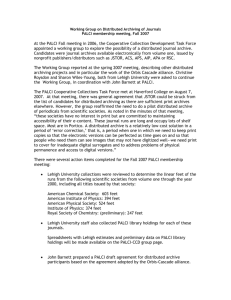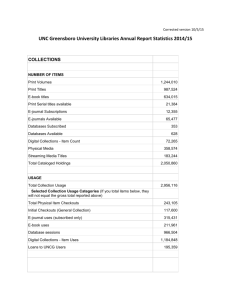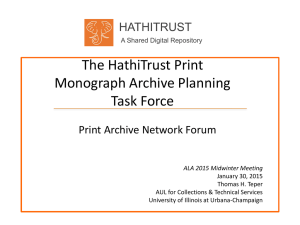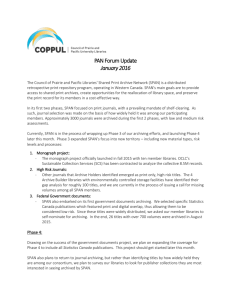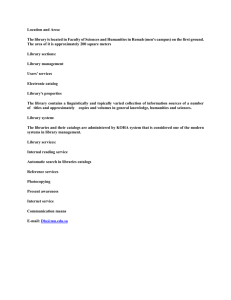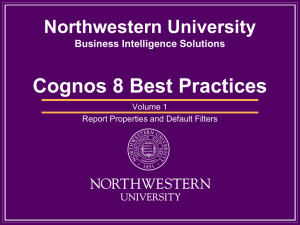- D-Scholarship@Pitt
advertisement
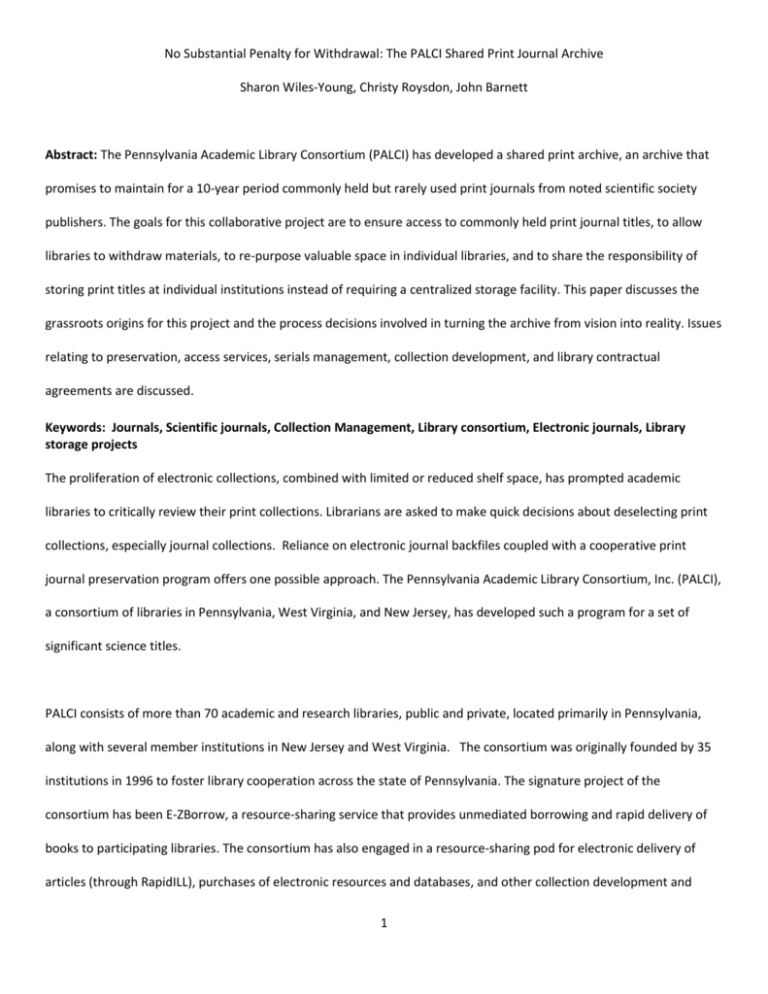
No Substantial Penalty for Withdrawal: The PALCI Shared Print Journal Archive Sharon Wiles-Young, Christy Roysdon, John Barnett Abstract: The Pennsylvania Academic Library Consortium (PALCI) has developed a shared print archive, an archive that promises to maintain for a 10-year period commonly held but rarely used print journals from noted scientific society publishers. The goals for this collaborative project are to ensure access to commonly held print journal titles, to allow libraries to withdraw materials, to re-purpose valuable space in individual libraries, and to share the responsibility of storing print titles at individual institutions instead of requiring a centralized storage facility. This paper discusses the grassroots origins for this project and the process decisions involved in turning the archive from vision into reality. Issues relating to preservation, access services, serials management, collection development, and library contractual agreements are discussed. Keywords: Journals, Scientific journals, Collection Management, Library consortium, Electronic journals, Library storage projects The proliferation of electronic collections, combined with limited or reduced shelf space, has prompted academic libraries to critically review their print collections. Librarians are asked to make quick decisions about deselecting print collections, especially journal collections. Reliance on electronic journal backfiles coupled with a cooperative print journal preservation program offers one possible approach. The Pennsylvania Academic Library Consortium, Inc. (PALCI), a consortium of libraries in Pennsylvania, West Virginia, and New Jersey, has developed such a program for a set of significant science titles. PALCI consists of more than 70 academic and research libraries, public and private, located primarily in Pennsylvania, along with several member institutions in New Jersey and West Virginia. The consortium was originally founded by 35 institutions in 1996 to foster library cooperation across the state of Pennsylvania. The signature project of the consortium has been E-ZBorrow, a resource-sharing service that provides unmediated borrowing and rapid delivery of books to participating libraries. The consortium has also engaged in a resource-sharing pod for electronic delivery of articles (through RapidILL), purchases of electronic resources and databases, and other collection development and 1 management projects. PALCI began as a grassroots organization, and the development of the distributed shared print archive leveraged the success of consortial resource sharing. In the year 2005/06, librarians from PALCI member institutions decided to explore shared collection development projects, building upon the success of consortium purchasing. A group of collection development librarians gathered to discuss many ideas, among them, disaster planning, cooperative monographic collection digital preservation, and shared remote storage. The need to free shelf space in critically overcrowded libraries emerged as the most urgent issue. Libraries were observing and measuring the decrease in use of journal print collections. Users were demanding more electronic content; electronic journal publishers were digitizing back files and creating digital archives; and space in libraries needed to be optimized for new user experiences. Libraries had begun to selectively withdraw bound print journals found in digitized collections such as JSTOR that were committed to digital preservation and had designated regional print repositories. At Lehigh University, the Libraries were acutely aware of the decrease in use of both current and bound print issues of journals and the overwhelming preference for the online format. Lehigh academic faculty agreed to the withdrawal of volumes in JSTOR collections. Librarians checked volumes to preserve only those that appeared to be incompletely or inadequately digitized at the present time, particularly with regard to images. An interesting event occurred recently at Lehigh that illustrates this reliance on electronic journals. JSTOR posted that they were experiencing some down time and students immediately began complaining on the library’s Facebook that they were “lost without JSTOR” and were pleading for its speedy return. In September 2009, the ITHAKA report, “What to Withdraw: Print Collections Management in the Wake of Digitization,” was publishedi. The report summarized that before withdrawing print materials, the content should be examined for amounts of visual materials, digital completeness of content, and quality of digitization. Preservation of print and access to the print are important considerations before making a withdrawal decision. The report does not specifically address 2 the importance of the artifactual value of the print volume (e.g., the value of a journal at an institution located where the journal is published or the value of a journal that has a long history or a journal that reflects an institution’s history within a discipline). The growth of PORTICO and other digital preservation services also raises questions about the continuing need for print journals to be stored nationally, regionally, or locally. As libraries started to withdraw print content from their libraries, options for regional storage received more attention. When a PALCI member survey conducted in 2006 confirmed an interest in shared storage, the consortium explored possibilities for a shared centralized storage facility. However, potential costs seemed out of reach. Additionally, at the time, there was concern expressed by some member libraries that a remote storage facility should not be too remote, given the geographic and transportation challenges of the region and the need for rapid access to research materials. A shared distributed print journal archive thus seemed more achievable. A regional print archive offers the advantages of using existing facilities, organizing a short term project, sharing the responsibility for preserving print, and allowing other libraries to withdraw linear feet of journals in a timely fashion with low costs to the institution. The consortium had in mind several guiding principles as it pursued its goal of creating a shared distributed print journal archive: • What type of archival arrangement would be suitable to our varied membership? The archive should serve each consortium member’s need for more space, for responsible deselection, and for preservation of important research literature. • Not all member institutions would have to provide holdings to the archive, but they would all benefit by its existence. • The agreement in place should have flexible terms, allowing participants some leeway in handling matters according to local needs or customs. The agreement would only need to be signed by libraries that were willing to provide holdings to the archive. Those benefitting from the archive’s existence but not providing holdings would not have to sign the agreement. 3 • The agreement’s terms should be flexible enough to allow a library to withdraw from participation if local conditions impelled it to do so (e.g., the library has to send all its volumes to remote storage or withdraw them all together). There should be no penalty for doing so, but the library, if possible, should allow the consortium the first chance to acquire any volumes slated for deselection. • At the same time, the agreement needed to be strong enough to meet the project’s aims: Stable regional holdings encouraging responsible deselection at the local level. • The arrangement should be low cost or even no cost to members, with minimal expenses borne by participating libraries. • The journals archived should have significant representation among member libraries; deselecting the titles chosen for the archive should have a major impact among PALCI libraries. • The holdings archived should begin with volume 1 for each journal and continue through publication year 2000. • Supplementary materials published for a journal should be archived as well, even if the supplementary materials were not published in print format. • There should be reliable electronic holdings for the journal already available to many members. • The journal issues archived should represent the “ideal copy” of the document, i.e., the copy should be in very good condition and be able highly suitable for use should the electronic copy “disappear.” • The arrangement should tie in with PALCI’s tradition of resource sharing. But what to archive? On which journals should the shared print archive focus? Initially, it was suggested that JSTOR titles be considered, but proponents soon realized that many institutions had either already withdrawn these titles from their collections or did not see them as deserving of regional attention as the titles were already well represented in other archives. The next idea was to examine the electronic journal back file collections that were available through PALCI’s cooperative purchasing agreements. Due to the results of this examination and because of the high reliance on electronic journals among science disciplines (and corresponding aversion to print in these disciplines), participants in PALCI’s Cooperative Collection Development Task Force recommended the archive preserve journal literature from the following scientific society publishers: American Institute of Physics (AIP), Institute of Physics (IOP), American Physical 4 Society (APS), and American Chemical Society (ACS). A core group of 18 institutions that held deep back files of these titles expressed interest in establishing and assisting in this endeavor, so the collections task force immediately went to work to establish a framework for the PALCI shared print archive. The collections task force identified similar projects and researched contract documents. The group discovered an agreement authored by the Orbis Cascade Alliance, a consortium of 36 members in Oregon and Washington, which had developed a distributed print journal archive in 2005/06. This consortium’s project served as a good model, and the consortium’s administrators generously shared their contract with the PALCI task force, with the contract serving as an excellent starting point for PALCI to draft its own agreement. In the meantime, journal titles for the selected scientific societies were being collected and entered into a spreadsheet. Each of the 18 institutions then received a copy of the spreadsheet to fill out and enter their summary holdings. Library staff at Lehigh University collected all the holdings and merged the holdings into one spreadsheet. The summary holdings were verified for complex title changes and then compared with the electronic journal title holdings. In the process, it was discovered that the electronic coverage of the IOP titles differed among participants and that some titles were not available in the PALCI contract back to volume 1. At this point, the collections task force decided to drop IOP society titles from inclusion in the distributed print archive—although it left the door open to revisit IOP’s inclusion at a later date. Once completed, the spreadsheet was examined, and it was concluded that there were enough institutions holding most of the titles to move ahead with the project. The collections task force then gathered to discuss and find consensus on the shared print archive’s aims, the project’s parameters, and the written agreement’s terms, which made formal the arrangement between those offering titles to the archive and PALCI. In the process, there was much debate over the number of archival copies to be maintained. Ultimately, in part this question was answered by the number of libraries participating and the breadth and depth of their holdings. In the end, the group decided to maintain 1 dark archive and 2 light archives, formalizing the holdings extant among member libraries. 5 Additionally at this gathering, the meaning of terms such as “dark archive” and “light archive” were debated extensively. For the purposes of the PALCI agreement, a light archive means materials can be used by staff and library users, either on-site or off-site and that the materials can circulate according to library circulation policies. A dark archive means materials can be handled by staff and library users can use the material on-site and that materials can be scanned or photocopied, but they cannot be lent to other libraries. Thus, in reality, PALCI’s light and dark archives are really more accurately described as “shades of gray” archives. The collections task force had thought the distinction between the uses of light and dark archive materials was solved early on in the discussions with the PALCI membership, but questions arose at various stages of the project about the need to lend print volumes and the viability of lending through interlibrary loan. There was also significant discussion over whether the agreement should guarantee holdings for anywhere from 5 years to 25 years, with the collections group and the PALCI board deciding, ultimately, on 10 years. Other parts of the original agreement, such as strict environmental controls needing to be in place for the archive and physically stamping volumes to indicate they belong to the archive, were eliminated altogether. In all cases, during the mid-term review set by the agreement, when the continuing success and usefulness of the archive will be examined, issues such as these will no doubt be revisited. The content of these discussions and debates was presented to the PALCI board and the PALCI membership at regular intervals. The collections task force also cited preliminary goals to be achieved by the project, with the archive aiming to Preserve copies of bound journals with one dark archive and two light archive copies for each title Remove duplication of print journal titles in PALCI member collections Potentially free up as much as 1,521 linear feet of shelving for each member library 6 Rather than one, two, or three libraries archiving all titles for the consortium, the project’s aim became to redistribute the titles so that every institution agreeing to participate would hold several titles. In this way, no one institution would carry too much of the burden for the entire consortium. By sharing the archival responsibility, many different libraries— large and small, public and private—could participate and have buy in for the project, all the while providing this service for the benefit of the entire consortium. The selection philosophy was to have every institution in the collections group hold at least one light archive title. For some titles, the holdings were sparse so as the collection group worked hard to distribute these titles to two large institutions that volunteered to serve as the light archive to all the titles in APS; other titles could be distributed to the smaller schools. This helped immensely with the distribution process. Finally, one institution, Pennsylvania State University, then offered to be the dark archive for all titles—ACS, AIP, and APS. As one of four Statewide Library Resource Centers designated by the Pennsylvania Library Code, Penn State has a responsibility to maintain collections for the benefit of all Pennsylvanians. As a result, Penn State has kept collections of bound journal titles and possesses a storage facility large enough to do so. This offer made the collections task force’s designation of light archive institutions much easier, and the distribution of titles was completed. It is important to note here that, as the collections task force recorded serial holdings information and hashed out details of the agreement, a few institutions were pressed to withdraw some of their print journal holdings for the titles to be held in the archive. One institution was told they were losing space in the library and were forced to move out bound journal titles very quickly. This event happened as the collections group was making final assignments of titles to institutions, complicating the process. Over the course of the project, other agreement details needed clarification. For example, how would the bibliographic and holdings information for each title be recorded? It was decided to be as flexible as possible and not require libraries that had never recorded holdings in a local holding record (LHR) on OCLC to begin to do so now. So the resolution was 7 that each library was to place the holdings and note in their respective online catalog the volumes kept permanently under the PALCI contract. In addition, the spreadsheet of journal titles and holdings documenting the member institutions preserving the title was to be placed on the PALCI website. Even during the review stage of the agreement, the process through which each participating institution’s administration determined whether it could adhere to the formal, written terms of the agreement, changes had to be made, some significant enough to prompt the task force to reevaluate its approach to the project. For example, to accommodate one library’s need, the notification period by which an institution could withdraw from the archive was shortened from 1 year to 6 months. Additionally, a last-minute addendum was included to allow one participating public university library to be able to accept transferred materials from other libraries in a way that did not run afoul of its governing body’s gifts law. This addendum allowed the library to purchase or borrow the transferred materials, rather than receive them as gifts, which, under state law, could not be disposed or given to another institution, should the library no longer be able to participate in the archive. Ultimately, however, the archive agreement was reviewed by each member institution and signed—in some cases by the collection development head, in other cases, by the library director, and in still others, by college/university legal counsel. Simultaneously, institutions participating in the agreement were verifying their volume holdings, issue by issue. Gaps were recorded and libraries asked other members to send the volumes that were needed and these transferred volumes became property of the designated library. This verification process of holdings took longer than expected because some members had their volumes already in storage. In other cases, some facilities were undergoing renovations and the collections were not immediately accessible. By spring 2011, everything was in place: The agreements were signed, transfers of materials were completed, and documentation and bibliographic data were entered. PALCI libraries could each potentially save a total of 1,521 linear feet of shelf space, and 13,000 volumes could be withdrawn from collections. 8 In less than five years, the libraries participating in the shared print archive will be reviewing the agreement and the parameters of the project. Questions will be asked and answered: Did any of the volumes circulate or were they lent to another library? Did anyone ask about these titles at all? Did anyone notice the PALCI notes in their online catalogs? Should we add the 583 preservation field to our member bibliographic and holding records? Should we add ISSN numbers to the PALCI title spreadsheet so PALCI can share holdings information and needs with other regional print storage initiatives? Has the project really been as low cost or no cost as we initially proposed—or are there hidden costs to our participants that we didn’t account for? What is going on with other regional print archives? How many regional print copies need to be stored and made available to library users in the future? Will we be able to recreate this model to archive other journals? How about books or other rapidlytransitioning-to-electronic-format library materials? Nevertheless, the overarching question for the PALCI consortium should be this: Was this project a success (however defined and assessed) for our institutions, our consortium, and our patrons? From the interest in this project by other libraries and library consortia both at home and abroad, we believe that our approach—one in which we allow a variety of libraries to participate as they are able and withdraw a local conditions warrant—can serve as a different, more flexible model for print journal storage. Sharon Wiles-Young is Director for Library Access Services at Lehigh University Libraries Christy Roysdon is Director of Library Collections and Systems at Lehigh University Libraries John Barnett is Scholarly Communications Librarian for the University Library System, University of Pittsburgh 9 NOTES i Roger C. Schonfeld and Ross Housewright, What to Withdraw? Print Collections Management in the Wake of Digitization, September 29, 2009. 10
